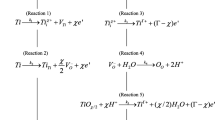Abstract
A simplified Point Defect Model incorporating reversible oxygen vacancy generation/annihilation at the metal/film interface has been used to investigate the impedance of anodized titanium in 0.5 M H2SO4, the oxygen vacancy profile in the anodic titanium oxide film, and the surface oxygen vacancy concentration. This simplified Point Defect Model (PDM), which considers the oxygen vacancy as the only point defect in the film, successfully accounts for the impedance of anodized titanium over the potential range explored. The results indicate that there is a thin region of the non-uniform oxygen vacancy concentration adjacent to the film/solution interface, which has an exponentially decreasing dopant (\( {V}_O^{\cdot \cdot } \)) concentration. The results of the investigation show that the surface oxygen vacancy concentration normalized to the bulk oxygen vacancy concentration is in the range of 0.05–0.15 and is essentially independent of potential.















Similar content being viewed by others
References
Roh B-W, Macdonald DD (2019) Passivity of titanium: part II, the defect structure of the anodic oxide film. J Solid State Electrochem 23(7):1967–1979
Macdonald DD, Roh B-W (2007) Impact of oxygen vacancies in anodic titanium oxide films on the kinetics of the oxygen electrode reaction - in honor of Dr. Boris Grafov. Russ J Electrochem 43(2):125
Chen G, Cho H, Macdonald DD, Mallouk TE, Warakas CC (2003) EIS studies of porous oxygen electrodes with discrete particles: I: Impedance of catalyst oxide supports. J Electrochem Soc 150(9):E423–E428
Chen G, Macdonald DD, Mallouk TE, Waraksa CC (2003) EIS studies of porous oxygen electrodes with discrete particles: II, Transmission line modeling. J Electrochem Soc 150(9):E429–E437
Sikora E, Sikora J, Macdonald DD (1996) Electrochim Acta 41(6):783–789
Sikora J, Sikora E, Macdonald DD (2000) Electrochim Acta 45(12):1875–1883
Chao C-Y, Lin L-F, Macdonald DD (1982) J Electrochem Soc 129(9):1874
Macdonald DD, Sun A, Priyantha N, Jayaweera P (2004) J Electroanal Chem 572(2):421–431
Macdonald DD (1992) J Electrochem Soc 139(12):3434
Macdonald DD (1999) Pure Appl Chem 71(6):951–978
Macdonald DD, Smedley SI (1990) Electrochim Acta 35(11-12):1949–1956
Macdonald DD (1977) Transient techniques in electrochemistry. Plenum Press, New York
Marsh J, Gorse D (1998) Electrochim Acta 43(7):659–670
Ohtsuka T, Masudo M, Sato N (1985) J Electrochem Soc 132(4):787
Engelhardt GR, Kursten B, Macdonald DD (2019) On the nature of the electric field within the barrier layer of a passive film. Electrochimica Acta 313:367–377
Nelder JA, Mead R (1965) Comput J 7(4):308–313
Mathews JH, Fink KD (2004) Numerical Methods Using Matlab. Prentice-Hall Inc, Upper Saddle River
Zhang L, Macdonald DD, Sikora E, Sikora J (1998) J Electrochem Soc 898:145
Beck TR (1973) J Electrochem Soc 120(10):1310
Ellerbrock D (1998) Defect characterization of titanium passive films, Ph. D. Dissertation, Penn State Univ., University Park, PA
Frayret C, Jaszay T, Lestienne B, Delville MH (2003) Electrochim Acta 48(12):1685–1695
Bockris JOM, Reddy AKN, Aldeco MG (2002) Modern Electrochemistry, volume 2A, Fundamentals of electrodics. Kluwer Academic/Plenum Publishers, Dordrecht
Pensado-Rodriguez O, Flores JR, Urquidi-Macdonald M, Macdonald DD (1999) J Electrochem Soc 146(4):1326
Macdonald DD (2005) Final technical report for the fundamental role of nano-scale oxide films in the oxidation of hydrogen and the reduction of oxygen on noble metal electrocatalysts, Grant No. DE-FG02-01ER15238
Zhu Y-C (1994) Elcetrochemical and surface analysis of anodic oxide film on titanium and stochastic analysis of pit generation processes on anodized titanium, Ph. D. Dissertation, Osaka University, Osaka, Japan
Acknowledgments
The authors gratefully acknowledge the support of this work at the Pennsylvania State University by the US Department of Energy through Grant No. DE-FG02-01ER15238 and by the Hyundai Motor Company. Additionally, Investigator No. 2 gratefully acknowledges the partial support of this work by FUTURE (Fundamental Understanding of Transport Under Reactor Extremes), an Energy Frontier Research Center funded by the U.S. Department of Energy (DOE), Office of Science, Basic Energy Sciences (BES) (neutron scattering studies).
Author information
Authors and Affiliations
Corresponding author
Additional information
“Passivity of titanium, part 1: film growth model diagnostics” was published in (2014) J Solid State Electrochem 18(5):1485–1493
“Passivity of titanium: part II, the defect structure of the anodic oxide film” was published in (2019) J Solid state Electrochem 23(7):1967–1979
“The passivity of titanium—part III: characterization of the anodic oxide film” was published in (2019) J Solid State Electrochem 23(7):2001–2008
Publisher’s note
Springer Nature remains neutral with regard to jurisdictional claims in published maps and institutional affiliations.
"Passivity of titanium, part I: film growth model diagnostics" was published in (2014) J Solid State Electrochem 18(5):1485-1493
"Passivity of titanium: part II, the defect structure of the anodic oxide film" was published in (2019) J Solid state Electrochem 23(7):1967-1979
"The passivity of titanium-part III: characterization of the anodic oxide film" was published in (2019) J Solid State Electrochem 23(7):2001-2008
Rights and permissions
About this article
Cite this article
Roh, B., Macdonald, D.D. Passivity of titanium, part IV: reversible oxygen vacancy generation/annihilation. J Solid State Electrochem 23, 2863–2879 (2019). https://doi.org/10.1007/s10008-019-04363-w
Received:
Revised:
Accepted:
Published:
Issue Date:
DOI: https://doi.org/10.1007/s10008-019-04363-w




